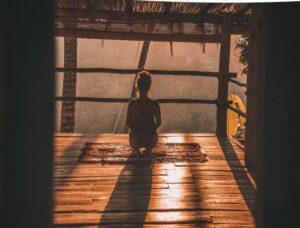Welcome to the enchanting world of Patagonia, a paradise for adventurers and nature enthusiasts. Nestled at the southern tip of South America, this awe-inspiring region is a treasure trove of natural wonders, offering a myriad of experiences for intrepid travelers.
From dramatic landscapes that take your breath away to thrilling hiking trails that lead to hidden gems, Patagonia promises an unforgettable journey of exploration and discovery. In this article, we will delve into the heart of Patagonia, uncovering its stunning vistas, vibrant wildlife, and the exhilarating experiences of hiking, camping, and beyond.
So, lace up your hiking boots, pack your camping gear, and get ready to embark on an extraordinary adventure as we unveil the wonders of Patagonia.
Patagonia: a Breath-taking Destination
Patagonia, a land of wonder and beauty, beckons adventurers and nature enthusiasts with its awe-inspiring landscapes and breathtaking vistas. Situated at the southernmost tip of South America, this captivating region boasts towering peaks, vast glaciers, and turquoise lakes that leave visitors spellbound.
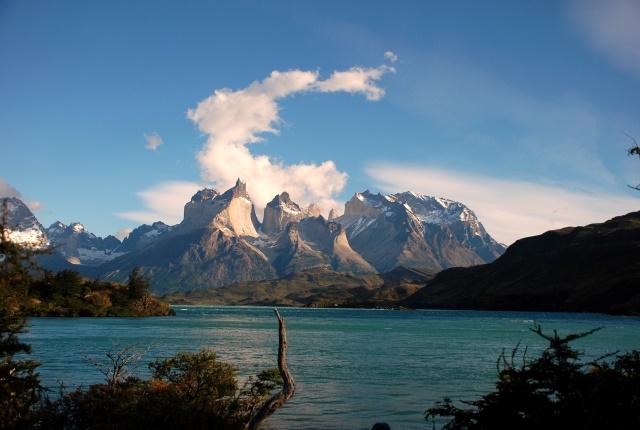
In this article, we will embark on a journey of discovery through the heart of Patagonia, exploring its rich biodiversity, vibrant wildlife, and the exhilarating experiences of hiking, camping, and more. So pack your sense of wonder as we unveil the magic and splendor of Patagonia’s natural wonders.
The Beauty of Patagonia
Stunning landscapes and diverse ecosystems
Situated at the southern tip of South America, this enchanting region is a haven of natural wonders. From majestic peaks piercing the sky to colossal glaciers carving their way through the land, Patagonia’s landscapes leave visitors in awe. Its turquoise lakes, verdant forests, and vast grasslands paint a picture of harmony and diversity.
Majestic mountains, glaciers, and pristine lakes
Majesty and Wonder boasts a breathtaking symphony of majestic mountains, sprawling glaciers, and pristine lakes. Nestled in the southernmost reaches of South America, this captivating region offers a visual feast that stirs the soul. Towering peaks rise proudly, adorned with snow-capped crowns that pierce the sky. Colossal glaciers command attention as they sculpt the rugged terrain, leaving a lasting mark on the landscape. Crystal-clear lakes mirror the surrounding beauty, inviting travelers to immerse themselves in their pristine waters.
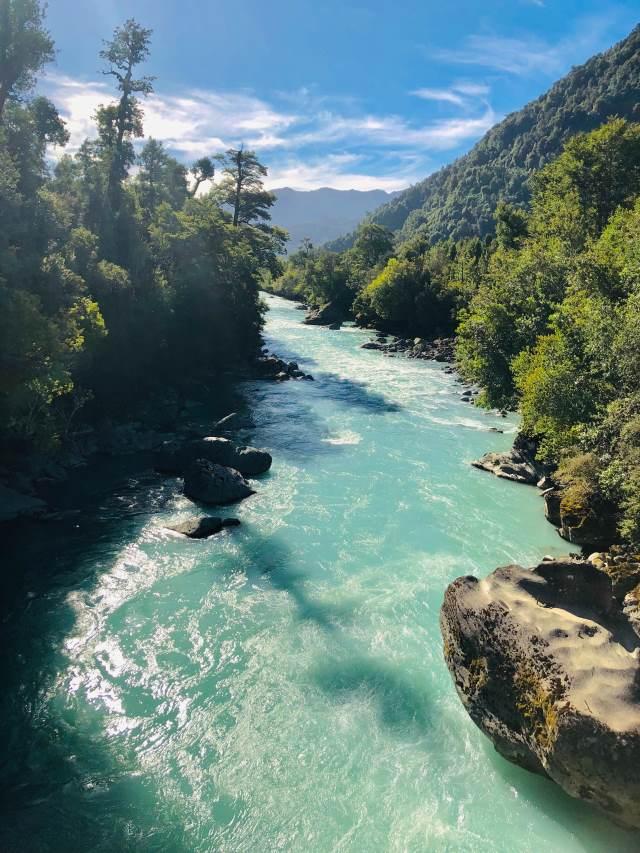
Rich wildlife and unique flora
A haven of biodiversity, Patagonia boasts rich wildlife and unique flora that form an exquisite tapestry of life. Nestled at the southernmost tip of South America, this enchanting region is a paradise for nature enthusiasts and wildlife lovers. From the graceful flight of majestic condors to the playful dance of guanacos across the vast grasslands, the wildlife in this area offers captivating encounters. Its unique flora, adapted to the challenging climate, reveals a delicate beauty in its resilience.
The Next Patagonian Adventure
Researching the best time to visit Patagonia
Located at the southern tip of South America, Patagonia experiences distinct seasons, each offering a unique experience. The summer months from December to February bring milder weather and longer daylight hours, making it an ideal time for hiking and outdoor activities.
However, this is also the peak tourist season, and popular sites can get crowded. Spring (September to November) and autumn (March to May) offer more tranquility and pleasant temperatures, making them great alternatives for a more intimate experience with nature. Winter (June to August) offers a different charm with snowy landscapes, ideal for those seeking a winter wonderland adventure.
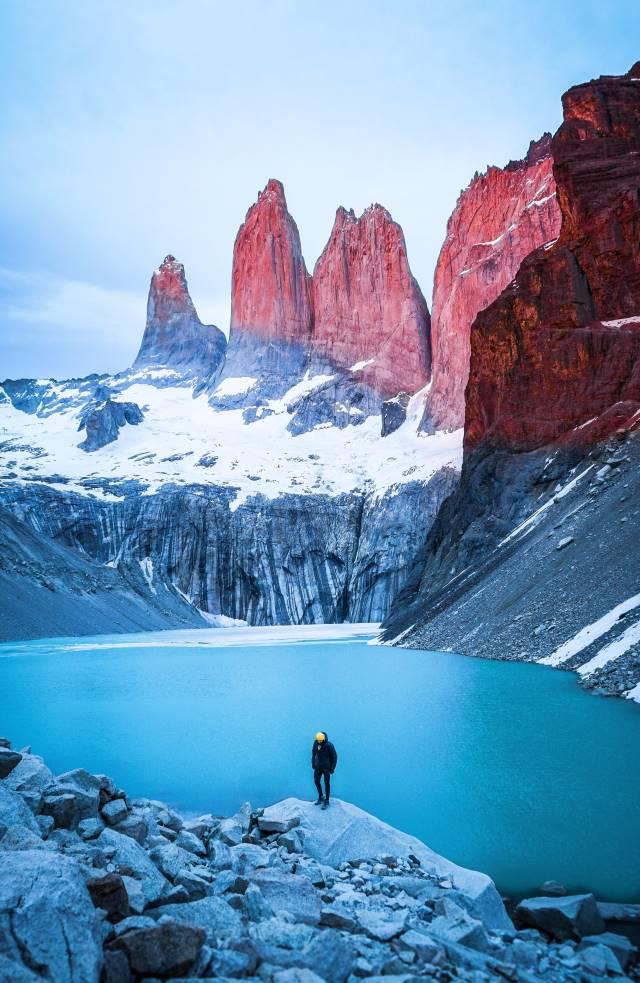
Researching weather patterns, trekking conditions, and your preferred activities will help you choose the best time to visit Patagonia. Whether you seek the lively energy of summer or the serene ambiance of spring and autumn, Patagonia promises an unforgettable journey, and proper research will ensure a truly remarkable experience.
Understanding the different regions and attractions
Understanding the different regions and attractions of Patagonia is crucial to curating an unforgettable itinerary in this diverse and vast land. Patagonia spans both Chile and Argentina, each offering unique landscapes and experiences.
In Chilean Patagonia, the Torres del Paine National Park stands as a crown jewel, renowned for its majestic granite peaks, turquoise lakes, and stunning hiking trails. The region also houses the Southern Patagonian Ice Field, the third-largest ice mass in the world, which creates awe-inspiring glaciers and fjords.
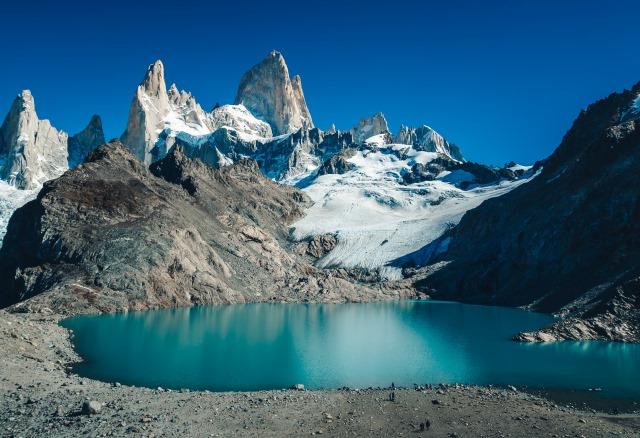
On the Argentine side, Los Glaciares National Park showcases the iconic Perito Moreno Glacier, a colossal ice formation that captivates visitors with its majestic movements. El Chaltén, known as the “Hiking Capital of Argentina,” offers incredible trekking opportunities amidst the Andean peaks.
The Lake District in northern Patagonia boasts picturesque lakes, lush forests, and charming towns like Bariloche, attracting visitors with its scenic beauty and outdoor adventures.
Understanding the distinct offerings of each region will help you plan an itinerary that caters to your interests and allows you to immerse yourself in the diverse wonders of Patagonia. Whether you seek jaw-dropping glaciers, epic hiking trails, or tranquil lakeside retreats, Patagonia’s regions and attractions promise an unforgettable adventure.
Obtaining necessary permits and reservations
Obtaining necessary permits and reservations is a crucial step when planning your Patagonian adventure. As this region comprises multiple national parks and protected areas, permits are required for certain activities to preserve the delicate ecosystems and manage visitor flow.
For Torres del Paine National Park in Chile, a reservation is essential to access the famous W or O Circuit treks. Due to the popularity of these routes, it’s best to secure reservations well in advance, especially during the peak summer months.
For Los Glaciares National Park in Argentina, permits are required for some hiking trails, including the Laguna de los Tres trek to Mount Fitz Roy. These permits help manage trail usage and ensure a more enjoyable experience for all visitors.
Additionally, if you plan to camp in either country’s national parks, you’ll need camping permits. The number of available campsites is limited, so booking in advance is vital, particularly during the high season.
Researching the specific permit requirements and reservation processes for your desired activities and locations will ensure a smooth and hassle-free experience in Patagonia. Prioritizing permits and reservations allows you to fully immerse yourself in the breathtaking landscapes and protected areas while respecting the region’s conservation efforts.
Hiking in Patagonia: Trails and Treks
Torres del Paine National Park
Hiking in Patagonia is a dream come true for outdoor enthusiasts, and Torres del Paine National Park stands as a beacon of adventure within this enchanting region. Renowned for its awe-inspiring landscapes, the park offers a plethora of trails and treks that cater to various levels of experience.
The “W” Circuit is one of the most famous routes, taking you through some of the park’s most iconic attractions. This multi-day trek leads you to the base of the Paine Towers, offering breathtaking views of the granite peaks reflected in the glacial lakes.
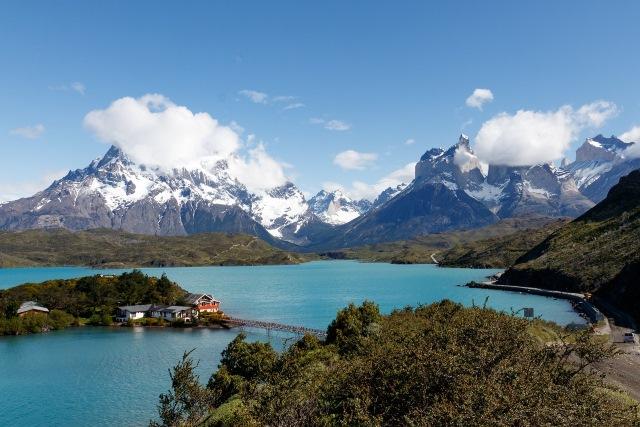
For a more challenging adventure, the “O” Circuit encompasses the “W” trail and extends deeper into the wilderness. This extended trek treats you to lesser-trodden paths and unveils hidden gems within the park.
For those seeking a shorter hike, the Mirador Cuernos trail provides a rewarding day hike with stunning views of the Cuernos del Paine, the distinct horn-shaped peaks that dominate the skyline.
Regardless of the trail you choose, a visit to Torres del Paine promises an unforgettable experience amidst the dramatic landscapes of Patagonia. From towering mountains to glacial lakes, each step on these trails unveils a natural wonder that will stay etched in your heart forever.
Los Glaciares National Park
Los Glaciares National Park, nestled in the heart of Argentine Patagonia, is a mecca for hikers seeking a glacial wonderland. This park is a UNESCO World Heritage site and boasts some of the most stunning landscapes in the world.
The Perito Moreno Glacier steals the spotlight, captivating visitors with its towering ice walls and dynamic movements. The park offers various viewpoints and walkways to witness this natural marvel up close.
For avid hikers, the Fitz Roy trek is a must-do. The trail leads you to the base of the iconic Mount Fitz Roy, surrounded by pristine lakes and lush forests. The Cerro Torre trek is equally rewarding, offering panoramic views of the Cerro Torre mountain and its ethereal spires.
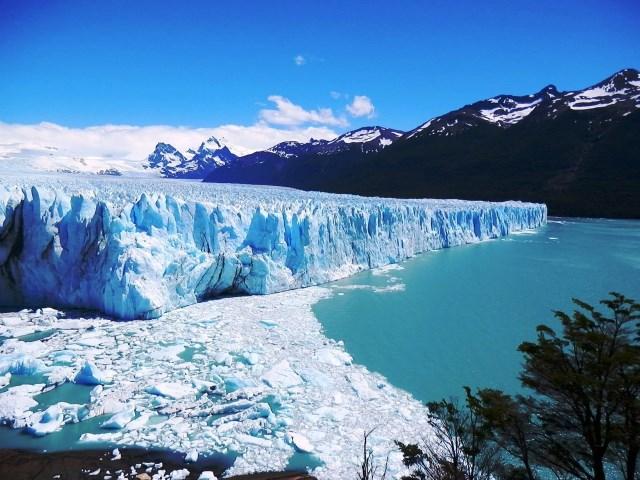
To immerse yourself in the ethereal beauty of Los Glaciares, the Laguna de los Tres trek is a challenging yet immensely rewarding experience. This trek culminates with awe-inspiring vistas of Mount Fitz Roy and its glacier-covered peaks.
As you explore Los Glaciares National Park, you’ll find yourself amidst a magical landscape that celebrates the grandeur of glaciers and the pristine beauty of Patagonia. Each trek and trail leads to a new revelation, and every step is an invitation to marvel at nature’s brilliance.
Fitz Roy Circuit
The Fitz Roy Circuit, also known as the Huemul Circuit, is an exhilarating and less-traveled trek that unveils the hidden gems of Los Glaciares National Park in Argentine Patagonia. This challenging multi-day trek offers a unique and immersive experience for seasoned hikers and adventurers.
The circuit takes you on a mesmerizing journey through the remote and untouched wilderness of the park. You’ll traverse ancient forests, crystal-clear rivers, and glacial valleys that lead to breathtaking viewpoints.
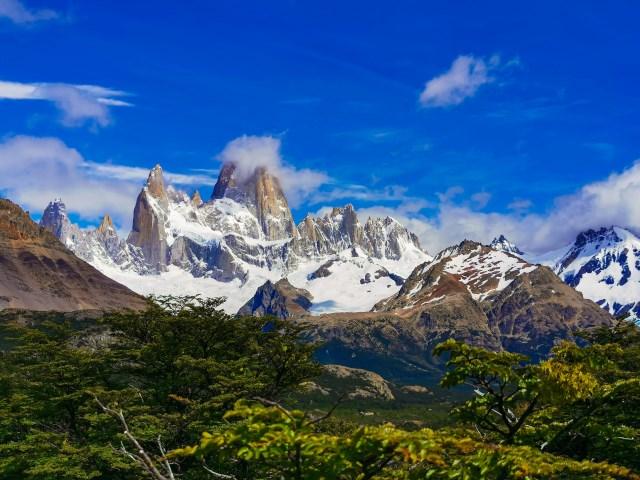
One of the highlights of the Fitz Roy Circuit is the breathtaking view of Mount Fitz Roy and Cerro Torre from the Paso del Viento. This vantage point offers a sense of awe and accomplishment, as you witness the sheer magnitude of these legendary peaks.
The trek also includes the opportunity to see various wildlife species, including guanacos, condors, and eagles, amidst the pristine landscapes of Patagonia.
The Fitz Roy Circuit provides a challenging but rewarding adventure, where every step immerses you in the untamed beauty of Patagonia. If you seek solitude and a deeper connection with nature, this lesser-known trek is a must-add to your bucket list of Patagonian experiences.
W Trek
The W Trek, a crown jewel of Torres del Paine National Park in Chilean Patagonia, is a world-renowned adventure that takes hikers on an unforgettable journey through some of the park’s most iconic landmarks.
As its name suggests, the trek forms a distinct “W” shape, leading you to the base of the Paine Towers, the striking granite peaks that define the skyline of the park. The journey commences at the park’s main entrance, leading you through diverse landscapes of dense forests, crystal-clear rivers, and awe-inspiring valleys.
The W Trek offers a range of accommodation options, from comfortable refugios to campgrounds, allowing you to tailor your experience to your preferences. Each day brings new vistas and wonders, culminating with the jaw-dropping view of the Torres del Paine reflected in the glacial lake at sunrise.
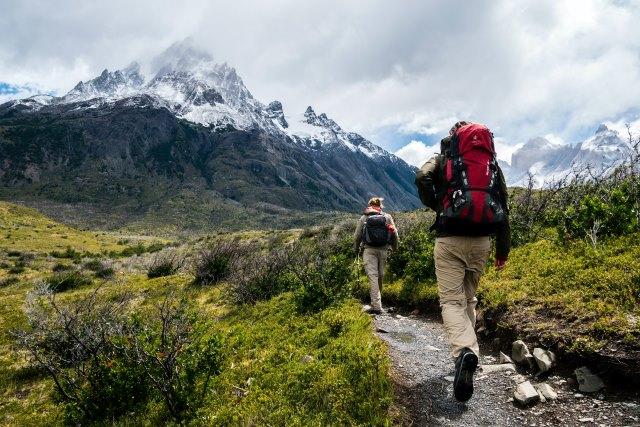
Along the way, you’ll encounter pristine glacial lakes, like Nordenskjöld and Pehoé, and witness the magnificent Grey Glacier up close.
The W Trek is suitable for hikers of varying experience levels and offers shorter day hikes for those seeking a more relaxed experience.
This classic Patagonian adventure promises an immersion into the untamed beauty of Torres del Paine, where each step offers a captivating encounter with nature’s grandeur. Whether you’re a seasoned trekker or a first-time hiker, the W Trek is a journey that will forever leave an indelible mark on your soul.
Camping in Patagonia: Immersing in Nature
Camping spots and campgrounds
Camping in Patagonia is an unparalleled opportunity to immerse yourself in the untamed beauty of this captivating region. With its vast wilderness and breathtaking landscapes, Patagonia offers a plethora of camping spots and campgrounds that cater to all types of adventurers.
Torres del Paine National Park in Chile is a prime destination for camping enthusiasts. The park provides well-maintained campgrounds, like Las Torres and Paine Grande, offering stunning views and convenient access to some of the most iconic trails.
For a more off-the-beaten-path experience, consider backcountry camping in the park. With proper permits and preparation, you can set up camp in pristine locations, enveloped by the serenity of nature.
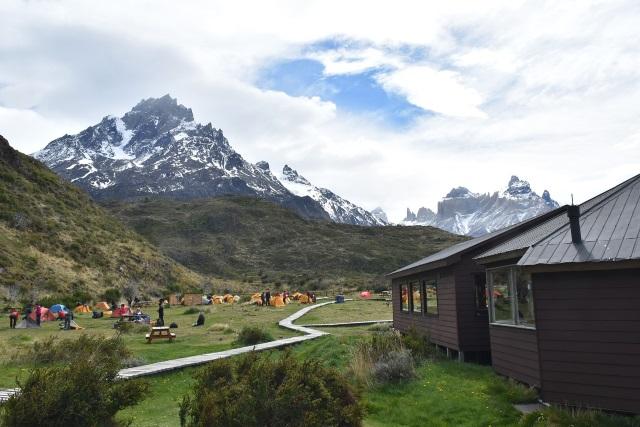
Los Glaciares National Park in Argentina also offers incredible camping opportunities. The area around Mount Fitz Roy boasts idyllic campgrounds like Poincenot and Capri, where you can wake up to the sight of majestic peaks.
El Chaltén, known as the “Hiking Capital of Argentina,” provides several free campsites, allowing trekkers to savor the true essence of Patagonia’s wilderness.
Throughout Patagonia, wild camping is also possible in certain areas, offering a chance to connect with nature on a deeper level. However, responsible camping practices are essential to preserve these pristine environments.
Camping in Patagonia allows you to embrace the raw beauty of this untouched land and experience the thrill of sleeping under the stars amidst snow-capped peaks and turquoise lakes. Whether you opt for established campgrounds or venture into the backcountry, camping in Patagonia promises a truly immersive and unforgettable nature experience.
Camping gear essentials for Patagonia’s changing weather
Camping in Patagonia’s ever-changing weather demands careful consideration of essential gear to ensure a comfortable and safe experience. The region’s unpredictable conditions require versatile equipment to tackle everything from sunshine to sudden rain and even snow.
- Weather-Resistant Tent: Opt for a sturdy and weather-resistant tent designed to withstand Patagonia’s strong winds and occasional rain. Look for a four-season tent that provides ample space and protection.
- Quality Sleeping Bag: Choose a high-quality sleeping bag with a temperature rating suitable for the coldest nights. Patagonia’s temperatures can drop significantly, especially in higher elevations.
- Insulated Sleeping Pad: Invest in a well-insulated sleeping pad to provide comfort and insulation from the cold ground. This is crucial for staying warm during chilly nights.
- Layered Clothing: Pack a variety of clothing layers to adapt to changing weather conditions. Include moisture-wicking base layers, insulating mid-layers, and a waterproof and windproof outer layer.
- Waterproof Gear: Ensure your rain jacket, rain pants, and backpack cover are waterproof and breathable. Patagonia is notorious for sudden rain showers, and staying dry is essential for comfort and safety.
- Sturdy Hiking Boots: Choose durable and waterproof hiking boots with good ankle support to navigate challenging terrains and keep your feet dry.
- Cooking Equipment: Bring a reliable camping stove and lightweight cookware for preparing warm meals, as cooking over open fires is not allowed in most areas.
- Water Purification: Carry a water filter or purification tablets to ensure a safe water supply. While many streams in Patagonia have clear water, it’s best to treat it before drinking.
- Headlamp: A headlamp is essential for navigating campsites and trails during the dark evenings and early mornings.
- Personal Items: Don’t forget essentials like sunscreen, insect repellent, a first aid kit, and a multi-tool.
Packing the right camping gear for Patagonia’s ever-changing weather will make your adventure more enjoyable and safe. Prepare for the elements, embrace the rugged beauty, and create unforgettable memories amidst the stunning landscapes of Patagonia.
Wildlife Encounters in Patagonia
Spotting iconic species
Wildlife encounters in Patagonia are a highlight of any visit to this pristine region, offering a chance to witness some of the world’s most iconic species in their natural habitats. Patagonia’s diverse landscapes provide a haven for a wide array of wildlife, making each encounter a thrilling and memorable experience.
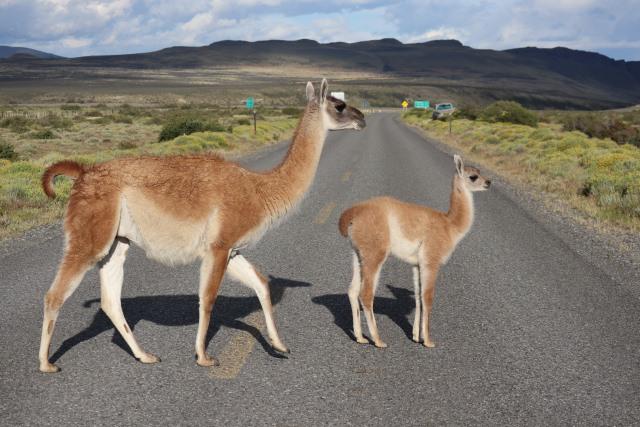
- Andean Condor: The magnificent Andean condor, with its impressive wingspan, is a symbol of the Andes and a common sight in Patagonia’s skies. Look up, and you might spot these graceful birds soaring above the rugged peaks.
- Guanaco: Patagonia’s vast grasslands are home to herds of guanacos, distant relatives of llamas. These elegant camelids roam freely in the region, offering delightful encounters during hikes and drives.
- Puma: The elusive and majestic puma, also known as the mountain lion or cougar, calls Patagonia home. While spotting them is rare, patient and quiet observers might be rewarded with a glimpse of these elusive predators.
- South Andean Deer: Also known as huemul, the South Andean deer is a national symbol and a rare sight in Patagonia. With its distinctive white face and antlers, spotting a huemul is a remarkable experience.
- Magellanic Penguin: Patagonia’s coastal regions host colonies of adorable Magellanic penguins. Visit Punta Tombo or Isla Magdalena for unforgettable encounters with these charming seabirds.
- Southern Right Whale: During the whale-watching season (May to December), the coastal waters of Patagonia become a playground for Southern right whales. Embark on a boat tour for a chance to witness these gentle giants breaching and playing in the ocean.
- Dolphins and Sea Lions: The coastal waters are also frequented by Commerson’s dolphins and playful sea lions, adding to the excitement of any coastal exploration.
Remember to maintain a respectful distance from the wildlife and adhere to park regulations to ensure their well-being and protection. Each wildlife encounter in Patagonia is a cherished moment that connects you to the natural wonders of this untamed region, making your journey all the more unforgettable.
Birdwatching opportunities
Patagonia is a birdwatcher’s paradise, offering abundant opportunities to spot a diverse array of avian species in their natural habitats. The region’s varied landscapes, from mountains to wetlands, create a haven for numerous resident and migratory birds.
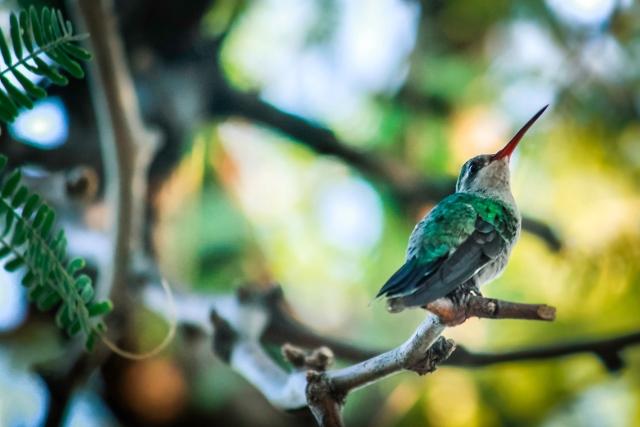
- Andean Condor: The emblematic Andean condor is a birdwatching highlight in Patagonia. With its impressive wingspan, it soars gracefully over the mountainous terrain, providing an awe-inspiring sight for observers.
- Magellanic Woodpecker: Patagonia’s ancient forests are home to the striking Magellanic woodpecker, one of the largest woodpecker species in the world. Its vibrant redhead and distinctive call make it a sought-after bird for birdwatchers.
- Austral Parakeet: This vibrant green parakeet is a common sight in the Patagonian forests. Its playful nature and lively colors add to the charm of any birdwatching experience.
- Black-browed Albatross: Along the coast, particularly in the Falkland Islands (Islas Malvinas), you can spot the elegant black-browed albatross soaring effortlessly over the ocean.
- Chimango Caracara: This raptor species is a frequent sight in Patagonia’s grasslands and open areas. Its scavenging behavior and striking appearance make it a fascinating subject for birdwatchers.
- Darwin’s Rhea: The ostrich-like Darwin’s rhea, also known as ñandú, roams the grassy plains of Patagonia. Observing these flightless birds in their natural habitat is an unforgettable experience.
- Torrent Duck: Patagonia’s rushing rivers and waterfalls are ideal habitats for the striking torrent duck. Its ability to navigate strong currents makes it a remarkable species to observe.
Birdwatching in Patagonia offers endless surprises and delightful encounters with a variety of feathered creatures. Whether you’re a seasoned birder or a casual observer, the region’s diverse avian life and breathtaking landscapes create an immersive and rewarding birdwatching experience. Grab your binoculars, and let Patagonia’s winged inhabitants enchant you on a remarkable journey through the natural wonders of this wild and captivating land.
Exploring Glaciers: Ice Hiking and Boat Tours
Ice hiking experiences
Exploring glaciers through ice hiking is an extraordinary adventure that allows you to step into a frozen world of wonder. Patagonia’s awe-inspiring glaciers offer thrilling opportunities to venture onto the ice, offering a unique and up-close encounter with these majestic ice formations.
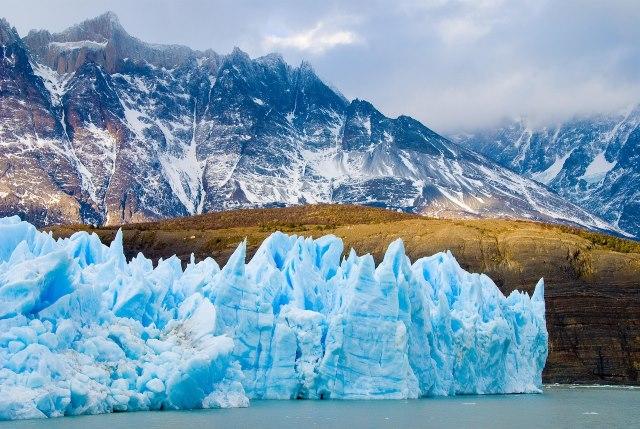
- Perito Moreno Glacier: In Los Glaciares National Park, the iconic Perito Moreno Glacier invites visitors to partake in guided ice hiking excursions. Equipped with crampons and led by experienced guides, you can explore the glacier’s mesmerizing crevasses, seracs, and ice formations, making it a must-do ice hiking experience.
- Viedma Glacier: Another gem in Los Glaciares National Park, the Viedma Glacier offers ice hiking tours that let you traverse the icy landscape and appreciate its stunning blue hues and mesmerizing ice caves.
- Grey Glacier: In Torres del Paine National Park, the Grey Glacier provides opportunities for ice hiking experiences amidst its azure ice formations. A boat ride across Grey Lake is followed by a walk on the glacier, offering a unique perspective on this natural wonder.
- Upsala Glacier: Navigating the icy waters of Lake Argentino, boat tours near the Upsala Glacier provide breathtaking views of its colossal ice walls. While ice hiking directly on the Upsala Glacier is not as common, the boat tour itself offers a captivating glimpse of its immense beauty.
Before embarking on an ice hiking adventure, ensure you’re accompanied by experienced guides and equipped with the necessary gear for safety. These excursions not only provide thrilling and unforgettable experiences but also create an appreciation for the magnitude and fragility of these colossal ice giants. Immerse yourself in the icy realm of Patagonia’s glaciers, and let these awe-inspiring encounters become cherished memories of your journey through this frozen wonderland.
Boat tours and cruises
Boat tours and cruises in Patagonia offer an exceptional way to explore the region’s mesmerizing landscapes, from the glacial fjords to the vast open waters. These nautical adventures provide a unique perspective, allowing you to witness the grandeur of Patagonia from the tranquil embrace of its lakes and seas.
- Magellan Strait Cruise: Cruising through the legendary Magellan Strait offers a historical and scenic journey. This waterway connects the Atlantic and Pacific Oceans, and on your voyage, you might spot marine wildlife like dolphins and seabirds.
- Beagle Channel Cruise: Sailing along the Beagle Channel takes you through the southernmost reaches of the continent. The channel offers breathtaking views of rugged coastlines, glaciers, and the iconic Les Eclaireurs Lighthouse.
- Glacier Cruises: Boat tours on the glacial lakes of Patagonia, such as Grey Lake or Argentino Lake, offer an up-close encounter with towering glaciers. Witness the calving ice walls and vibrant blue hues of these natural wonders.
- Fjord Exploration: Some boat tours take you through the stunning fjords of Patagonia, like the Sarmiento Fjord or the Brüggen Fjord, where dramatic cliffs and hanging glaciers create a surreal landscape.
- Whale Watching: During the whale-watching season (May to December), boat tours off the coast of Peninsula Valdés provide opportunities to observe majestic Southern right whales and playful dolphins.
- Falkland Islands Exploration: Cruise voyages to the Falkland Islands (Islas Malvinas) offer encounters with diverse birdlife, including penguins and albatrosses, as well as historical sites and charming settlements.
Patagonia’s boat tours and cruises cater to different interests and durations, allowing you to choose the one that best fits your preferences. Whether it’s gliding past glaciers, spotting wildlife, or immersing in the region’s rich history, these nautical adventures promise an unforgettable journey through the enchanting waters of Patagonia.
Cultural Experiences in Patagonia
Learning about the indigenous cultures and their traditions
Cultural experiences in Patagonia offer a unique opportunity to connect with the rich heritage of the region’s indigenous peoples and gain insights into their fascinating traditions and way of life. The indigenous cultures of Patagonia have a profound connection with the land, and their knowledge and customs have been passed down through generations.
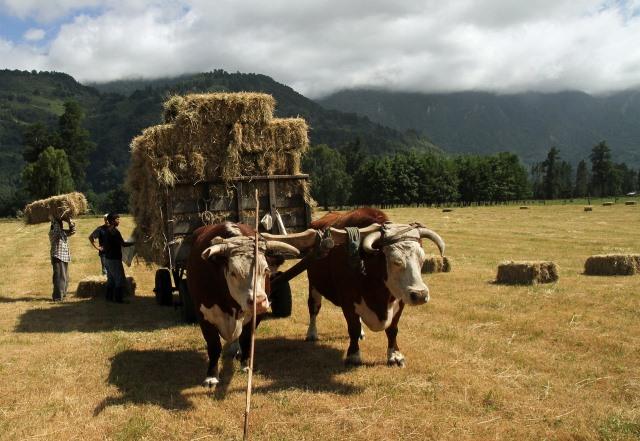
- Mapuche Community Visits: The Mapuche people are one of the largest indigenous groups in Chile, and some communities in Patagonia welcome visitors to learn about their customs and beliefs. Engaging in traditional ceremonies, like the “Ngillatun,” provides a glimpse into their spiritual practices.
- Aonikenk Culture: In Argentine Patagonia, you may encounter the Aonikenk people, also known as the Tehuelche. Some cultural centers and local communities offer activities like storytelling and craft workshops, showcasing their deep-rooted traditions.
- Rapanui Influence: On Chiloé Island, the indigenous Huilliche people have been influenced by the Rapanui culture from Easter Island. Visiting Chiloé provides a unique blend of traditions, including distinctive architecture and folklore.
- Artisan Markets: Throughout Patagonia, you can find artisan markets featuring handmade crafts and artwork created by indigenous communities. Purchasing these items supports their livelihoods and preserves their cultural heritage.
- Traditional Cuisine: Indulge in traditional indigenous dishes, like curanto or cazuela, which reflect the region’s culinary roots and ancestral ingredients.
- Museums and Cultural Centers: Various museums and cultural centers in Patagonian cities provide exhibits and educational programs that shed light on the history and customs of the indigenous peoples.
Respect and understanding are essential when engaging with indigenous cultures. Prioritize guided experiences and community-led initiatives that aim to empower and preserve the heritage of these communities. Embracing Patagonia’s cultural experiences allows you to go beyond the natural wonders and connect with the deep-rooted traditions that shape this extraordinary land.
Visiting local communities
Visiting local communities in Patagonia offers a chance to engage with the region’s warm hospitality and experience authentic cultural interactions. Embracing local life and customs allows you to gain a deeper appreciation for the vibrant tapestry of Patagonia’s diverse communities.
- Gaucho Experience: In rural areas of Argentine Patagonia, you can visit estancias (ranches) and spend time with gauchos, skilled horsemen who embody the cowboy culture. Participate in traditional activities like herding cattle or enjoying an asado (barbecue) to immerse in their way of life.
- Folkloric Festivals: Throughout the year, many Patagonian communities celebrate folkloric festivals, showcasing traditional music, dance, and attire. Attending these events offers a vibrant insight into local customs and cultural expressions.
- Homestays: Some communities welcome visitors to stay with local families, providing an intimate experience of daily life and the chance to share meals and stories together.
- Language and Crafts Workshops: Participate in language workshops to learn the basics of indigenous languages, or engage in craft workshops to create traditional handicrafts alongside local artisans.
- Local Markets: Explore local markets to interact with residents and discover unique products, from artisan crafts to regional delicacies.
- Community Projects: Support community-led projects by volunteering or contributing to initiatives that focus on sustainable development and cultural preservation.
When visiting local communities, always approach with respect, humility, and a genuine interest in their way of life. Learn some basic phrases in the local language, be open to trying new foods, and show appreciation for their customs and traditions. By fostering meaningful connections with the people of Patagonia, you’ll create cherished memories and contribute positively to the preservation of their culture and heritage.
Traditional cuisine and regional delicacies
Traditional cuisine and regional delicacies in Patagonia offer a delightful journey for your taste buds, reflecting the unique flavors and culinary heritage of the region. From hearty meats to fresh seafood, Patagonian cuisine showcases a blend of indigenous, European, and regional influences.
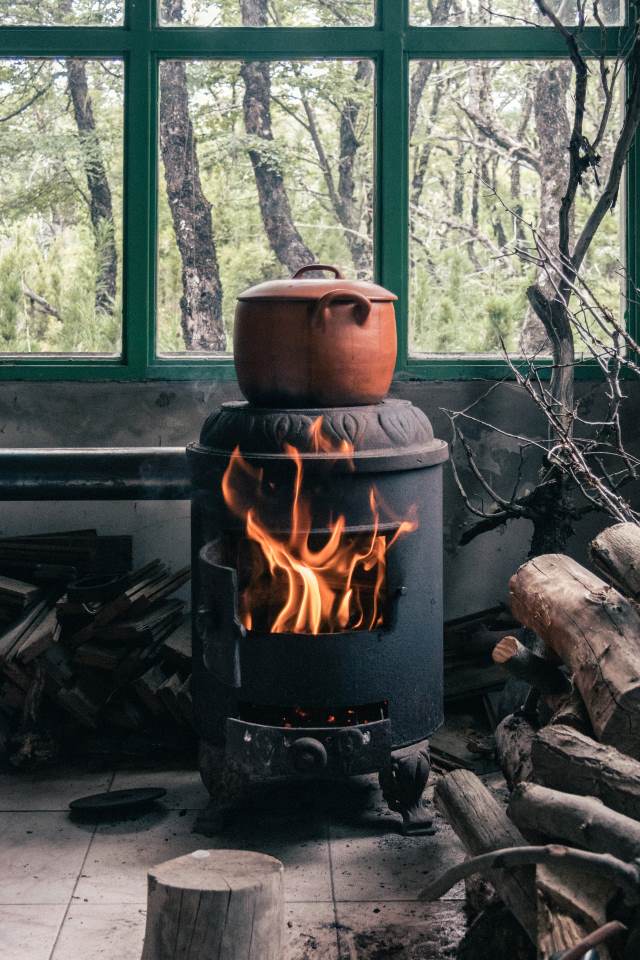
- Asado: A quintessential Argentine barbecue, the asado, is a must-try culinary experience in Patagonia. It features various cuts of succulent meats, such as beef, lamb, and pork, slow-cooked over an open flame, infusing the meat with rich smoky flavors.
- Curanto: Hailing from the Chiloé Archipelago, curanto is a traditional dish prepared by burying seafood, meat, and vegetables in a pit lined with hot stones. The result is a delicious blend of flavors that reflects the region’s indigenous and cultural heritage.
- Cazuela: A comforting and hearty stew, cazuela, is a popular dish in Chilean Patagonia. Made with various meats, potatoes, corn, and vegetables, it provides a satisfying taste of home-cooked comfort.
- Locro: Originating from Argentina, locro is a flavorful soup made with white corn, vegetables, and meat. It is often enjoyed during chilly days, making it a perfect match for Patagonia’s cool climate.
- Centolla: Patagonia’s cold waters are home to an abundance of seafood, including centolla, or king crab. This prized delicacy is often served fresh and showcases the region’s oceanic bounty.
- Berries: Patagonia’s vast landscapes offer an abundance of wild berries, such as calafate and maqui. These berries are used to make delicious jams, desserts, and even beverages.
- Mate: A beloved social and cultural ritual in Argentina, mate is a traditional herbal drink shared among friends and family. Sipping mate while enjoying the stunning scenery is a cherished Patagonian experience.
- Lamb Patagonia: Renowned for its tender and flavorful taste, Patagonian lamb is a culinary delight often prepared using traditional cooking methods, such as asado or on a spit.
Embrace the regional delicacies of Patagonia, and savor the blend of flavors that reflect the history and cultural influences of the land. From the vast pampas to the rugged mountains, each dish tells a unique story, inviting you to indulge in the culinary treasures of this remarkable region.
Conclusion
Exploring the wonders of Patagonia is a journey like no other, where nature’s grandeur, adventurous pursuits, and vibrant cultures unite to create an unforgettable experience. From the majestic peaks of the Andes to the icy embrace of glaciers, Patagonia’s landscapes evoke a sense of awe and wonder. Hiking through the pristine wilderness, camping under starlit skies, and embarking on boat tours that navigate through untamed waters offer a profound connection with the natural world.
But Patagonia’s allure extends beyond its breathtaking scenery. Engaging with the region’s indigenous cultures and local communities adds a deeper layer to the adventure. Sharing in their traditions, tasting the richness of traditional cuisine, and embracing their warm hospitality enriches the journey with authentic and meaningful experiences.
As you traverse this remote and enchanting land, remember to approach it with respect, mindfulness, and a sense of curiosity. Embrace the spirit of adventure, for Patagonia rewards those who venture with boundless wonders and transformative moments.
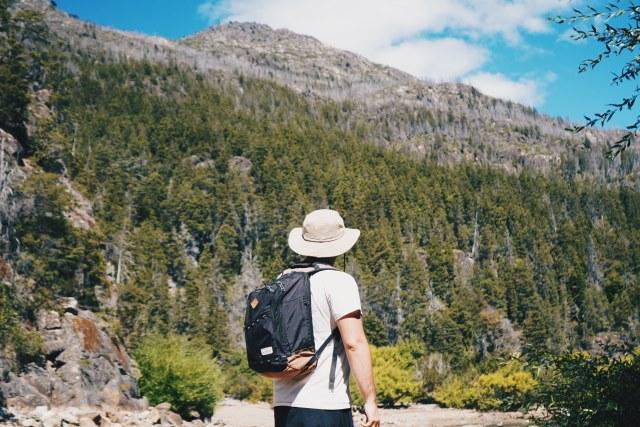
Whether you’re an avid hiker seeking mountain summits, a nature lover yearning for wildlife encounters, or a cultural enthusiast eager to connect with the people of the land, Patagonia offers something special for everyone. Its allure lies not just in its striking landscapes, but in the way it touches the soul and leaves an indelible mark on the heart.
So, pack your bags, lace up your hiking boots, and embark on a journey that promises to awaken your senses, ignite your spirit of exploration, and immerse you in the untamed beauty of Patagonia. A destination of dreams, Patagonia awaits, ready to unveil its hidden treasures and invite you into a world where adventure, culture, and nature intertwine in harmony.
FAQs:
Are there age restrictions for hiking and camping in Patagonia?
There are no specific age restrictions for hiking and camping in Patagonia; however, it’s essential to consider the physical demands of the activities and the individual’s fitness level. Some hikes, such as the more challenging treks, may require a higher level of endurance and stamina. Families with children should opt for shorter and more accessible trails suitable for young hikers. It’s crucial to choose hikes and camping locations that align with the abilities and comfort of all participants.
Is it necessary to hire a guide for hiking in Patagonia?
While hiring a guide is not mandatory for all hiking experiences in Patagonia, it is highly recommended, especially for treks in remote areas or those with challenging terrains. Local guides possess valuable knowledge of the region’s geography, weather patterns, and safety protocols, ensuring a safer and more enriching adventure.
They can also share insights into the local culture and flora and fauna, enhancing the overall experience. For those less experienced or unfamiliar with the area, a guide can be instrumental in maximizing enjoyment and minimizing potential risks.
Are there accommodations other than camping in Patagonia?
Yes, Patagonia offers various accommodations beyond camping. From cozy lodges and charming hostels to luxury eco-lodges, there are options to suit every traveler’s preference and budget. Many national parks and popular trekking areas have established refugios (mountain huts) that offer basic lodging and amenities along the trails. Additionally, small towns and cities in the region provide hotels, lodges, and guesthouses for a comfortable stay.
How can I contribute to the preservation of Patagonia’s environment?
Preserving Patagonia’s environment is crucial to maintaining its beauty and ecological balance. Visitors can contribute to conservation efforts by practicing Leave No Trace principles, which include disposing of waste responsibly and respecting wildlife and natural habitats. Supporting local eco-friendly businesses and purchasing sustainable products can have a positive impact on the region’s economy and sustainability.
Additionally, participating in community-led initiatives, such as volunteering for environmental projects or donating to conservation organizations, can further contribute to the preservation of Patagonia’s unique and fragile ecosystem. By being conscious travelers, we can ensure that future generations can continue to marvel at the wonders of this pristine and wild land.

